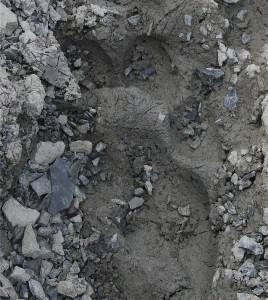Yury Yarovenko
Other projects
15 Feb 2011
GIS Mapping of Habitats and Further Field Research to Identify the Priority Leopard (Panthera pardus) Areas in Dagestan, Russian North Caucasus
This project will use camera-trapping, dietary analysis, presence/absence surveys and outreach awareness-raising to better understand the status of the leopard and to promote its conservation in Dagestan.

A putative leopard track.
The leopard has been a symbol of the Caucasus Mountains, particularly in Dagestan. Meantime, it was never studied before 2008 and all information about its distribution and status used to be gleaned within the other non-target projects. Our first Rufford project confirmed the leopard presence in the 3 key and most out-of-the-way areas in the mountains of south-western Dagestan (Tsoloda, Charovali and Mekhelta).

One of the main canyons where leopards are frequently recorded.
In this project, we will focus on camera-trapping, dietary analysis from scats and prey remains, and surveys of leopard presence signs (scats, tracks, scrapes) to better understand the status of the leopard in these 3 areas. Also, we will promote our cooperation with local people, military personnel and authorities and raise public awareness about leopard conservation through production and dissemination of wall calendars.
Results of this project will give us the first-hand and unique information about the leopard ecology (number, population structure, distribution and diet) in Dagestan essential for initiation of the large-scale leopard conservation activities. The “hot spots” comprising the key leopard habitats will be recommended to relevant conservation bodies for priority protection. The first-ever data on leopard diet will allow to determine the urgent directions in working with local people. For example, if this predator is found out to subsist mostly on livestock predation, then the highlight of its conservation would rest on non-invasive anti-predator tactics (use of shepherd dogs, aversion training, compensation approaches) and on increasing the abundance of wild prey species. The wall calendars appealing for leopard conservation will stay year-round within the people’s field of view and get imprinted in their minds for a long time ahead. Participation in field research will grant locals an essential feeling of being confided and demanded in conservation of the Dagestan’s gem, the leopard.
The project results will be presented to the republic’s scientific and conservation societies, widely disseminated across the mass media and used to lobby the establishment of protected areas for the leopard conservation in Dagestan. This will enable to promote public awareness all over Dagestan and not only within the scattered rural communities.